Employment Law: Final Exam Questions and Answers - Analysis
VerifiedAdded on 2023/04/22
|14
|2597
|422
Homework Assignment
AI Summary
This document provides a comprehensive analysis of employment law final exam questions. It addresses various legal issues, including worker's compensation, workplace safety, wrongful dismissal, and the application of relevant legislation such as the Fair Work Act 2009. The solutions examine scenarios involving employee injuries, employer responsibilities, and the legal implications of actions by both employers and employees. The document also covers topics like patent law, disability discrimination, and collective bargaining, providing detailed explanations and references to relevant case law, such as Kavanagh v. The Commonwealth, Sorby v Commonwealth, and the Disability Discrimination Act of 1992. The answers are structured using the issue, rule, application, and conclusion format, offering a clear and organized approach to understanding complex legal concepts and applying them to real-world situations. The document serves as a valuable resource for students studying employment law, offering insights into exam preparation and legal analysis.
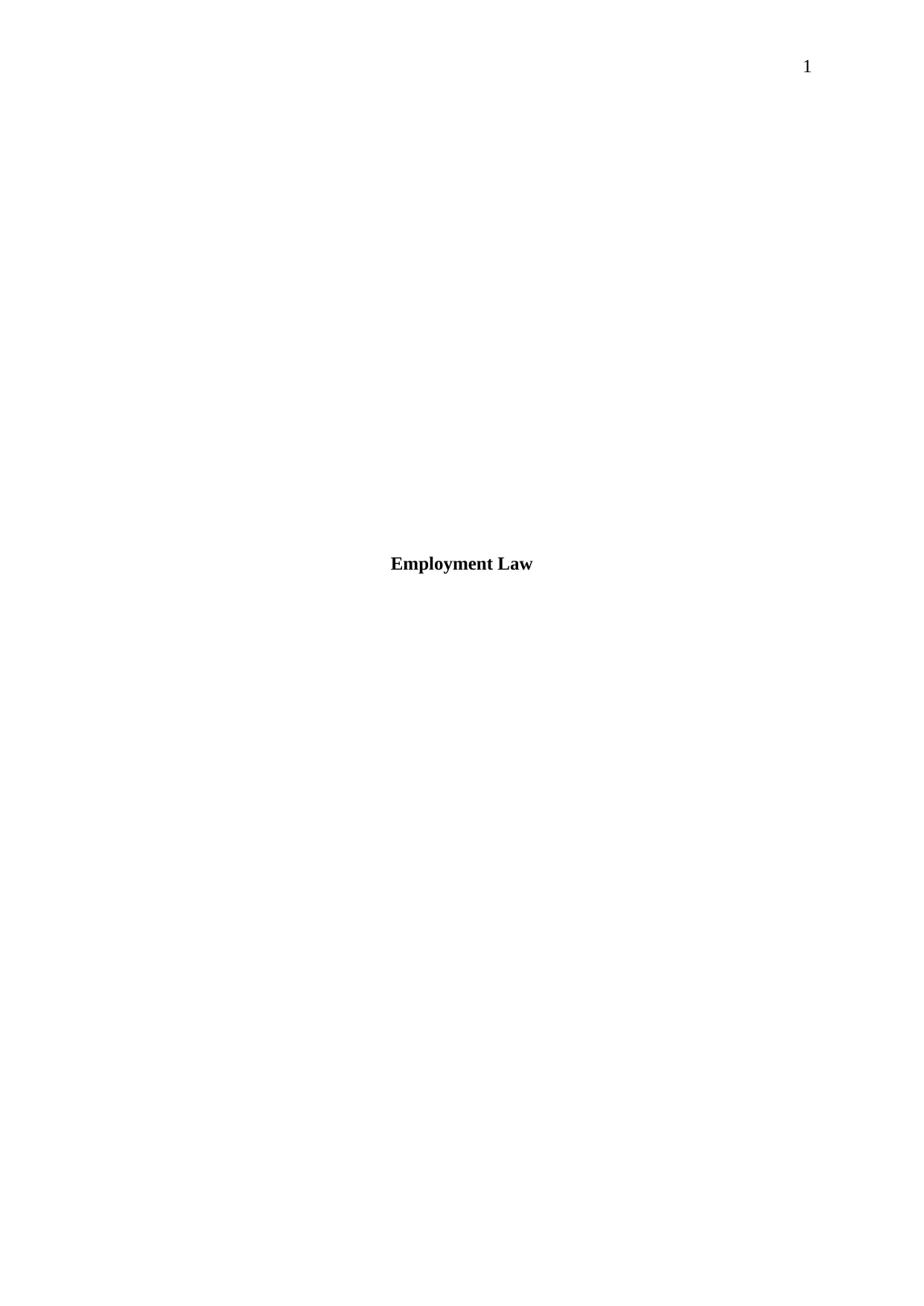
1
Employment Law
Employment Law
Paraphrase This Document
Need a fresh take? Get an instant paraphrase of this document with our AI Paraphraser
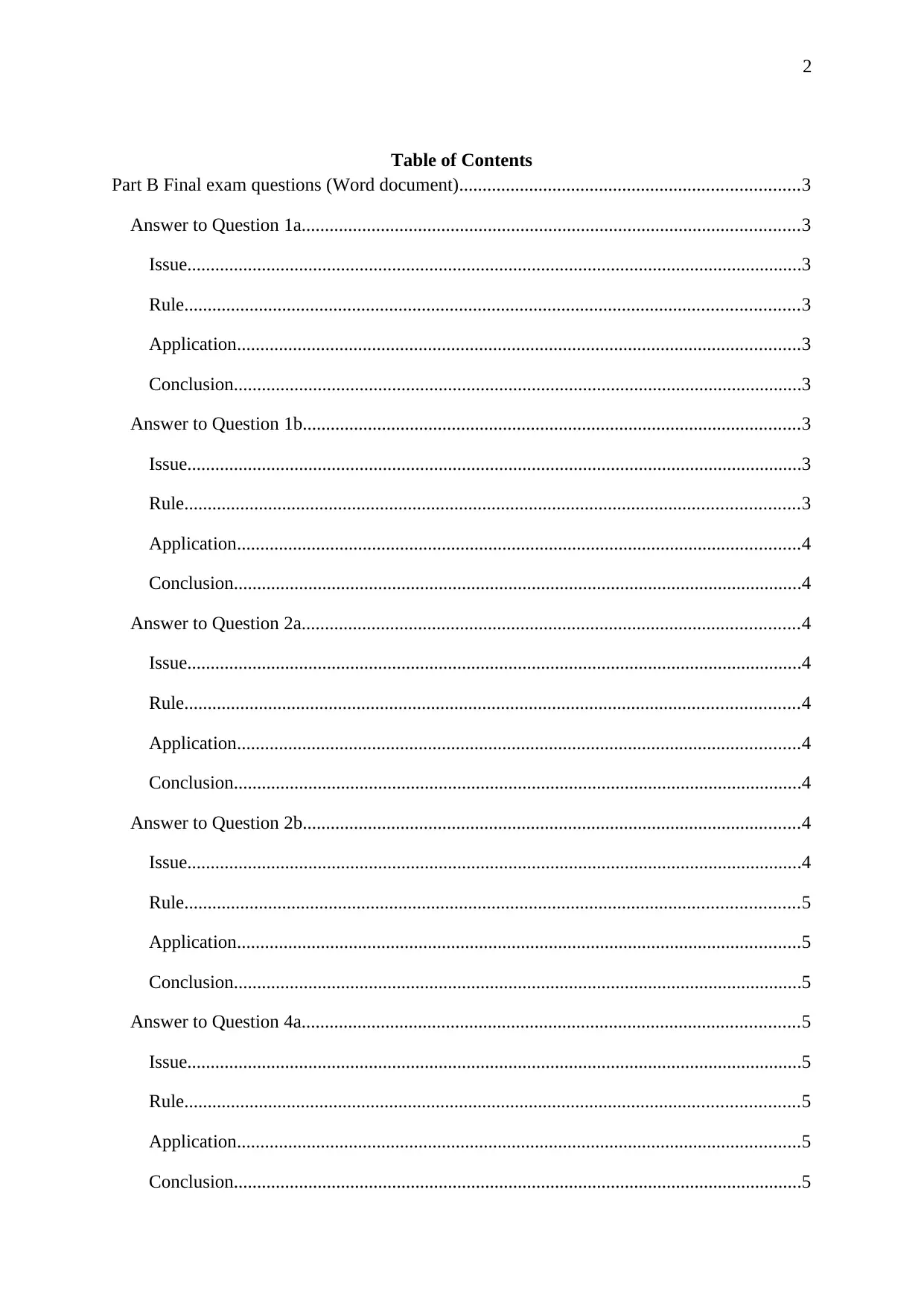
2
Table of Contents
Part B Final exam questions (Word document).........................................................................3
Answer to Question 1a...........................................................................................................3
Issue....................................................................................................................................3
Rule....................................................................................................................................3
Application.........................................................................................................................3
Conclusion..........................................................................................................................3
Answer to Question 1b...........................................................................................................3
Issue....................................................................................................................................3
Rule....................................................................................................................................3
Application.........................................................................................................................4
Conclusion..........................................................................................................................4
Answer to Question 2a...........................................................................................................4
Issue....................................................................................................................................4
Rule....................................................................................................................................4
Application.........................................................................................................................4
Conclusion..........................................................................................................................4
Answer to Question 2b...........................................................................................................4
Issue....................................................................................................................................4
Rule....................................................................................................................................5
Application.........................................................................................................................5
Conclusion..........................................................................................................................5
Answer to Question 4a...........................................................................................................5
Issue....................................................................................................................................5
Rule....................................................................................................................................5
Application.........................................................................................................................5
Conclusion..........................................................................................................................5
Table of Contents
Part B Final exam questions (Word document).........................................................................3
Answer to Question 1a...........................................................................................................3
Issue....................................................................................................................................3
Rule....................................................................................................................................3
Application.........................................................................................................................3
Conclusion..........................................................................................................................3
Answer to Question 1b...........................................................................................................3
Issue....................................................................................................................................3
Rule....................................................................................................................................3
Application.........................................................................................................................4
Conclusion..........................................................................................................................4
Answer to Question 2a...........................................................................................................4
Issue....................................................................................................................................4
Rule....................................................................................................................................4
Application.........................................................................................................................4
Conclusion..........................................................................................................................4
Answer to Question 2b...........................................................................................................4
Issue....................................................................................................................................4
Rule....................................................................................................................................5
Application.........................................................................................................................5
Conclusion..........................................................................................................................5
Answer to Question 4a...........................................................................................................5
Issue....................................................................................................................................5
Rule....................................................................................................................................5
Application.........................................................................................................................5
Conclusion..........................................................................................................................5
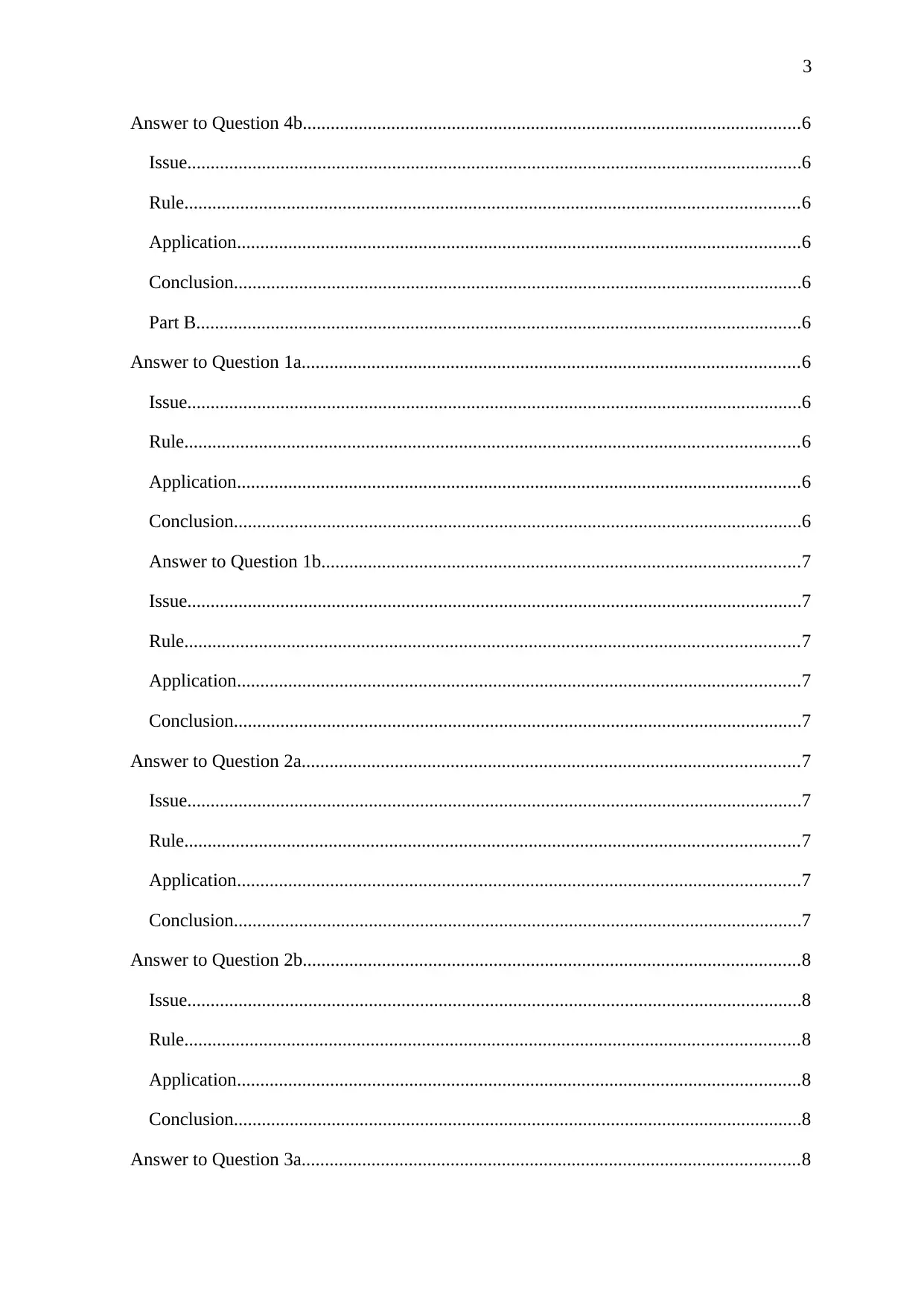
3
Answer to Question 4b...........................................................................................................6
Issue....................................................................................................................................6
Rule....................................................................................................................................6
Application.........................................................................................................................6
Conclusion..........................................................................................................................6
Part B..................................................................................................................................6
Answer to Question 1a...........................................................................................................6
Issue....................................................................................................................................6
Rule....................................................................................................................................6
Application.........................................................................................................................6
Conclusion..........................................................................................................................6
Answer to Question 1b.......................................................................................................7
Issue....................................................................................................................................7
Rule....................................................................................................................................7
Application.........................................................................................................................7
Conclusion..........................................................................................................................7
Answer to Question 2a...........................................................................................................7
Issue....................................................................................................................................7
Rule....................................................................................................................................7
Application.........................................................................................................................7
Conclusion..........................................................................................................................7
Answer to Question 2b...........................................................................................................8
Issue....................................................................................................................................8
Rule....................................................................................................................................8
Application.........................................................................................................................8
Conclusion..........................................................................................................................8
Answer to Question 3a...........................................................................................................8
Answer to Question 4b...........................................................................................................6
Issue....................................................................................................................................6
Rule....................................................................................................................................6
Application.........................................................................................................................6
Conclusion..........................................................................................................................6
Part B..................................................................................................................................6
Answer to Question 1a...........................................................................................................6
Issue....................................................................................................................................6
Rule....................................................................................................................................6
Application.........................................................................................................................6
Conclusion..........................................................................................................................6
Answer to Question 1b.......................................................................................................7
Issue....................................................................................................................................7
Rule....................................................................................................................................7
Application.........................................................................................................................7
Conclusion..........................................................................................................................7
Answer to Question 2a...........................................................................................................7
Issue....................................................................................................................................7
Rule....................................................................................................................................7
Application.........................................................................................................................7
Conclusion..........................................................................................................................7
Answer to Question 2b...........................................................................................................8
Issue....................................................................................................................................8
Rule....................................................................................................................................8
Application.........................................................................................................................8
Conclusion..........................................................................................................................8
Answer to Question 3a...........................................................................................................8
⊘ This is a preview!⊘
Do you want full access?
Subscribe today to unlock all pages.

Trusted by 1+ million students worldwide
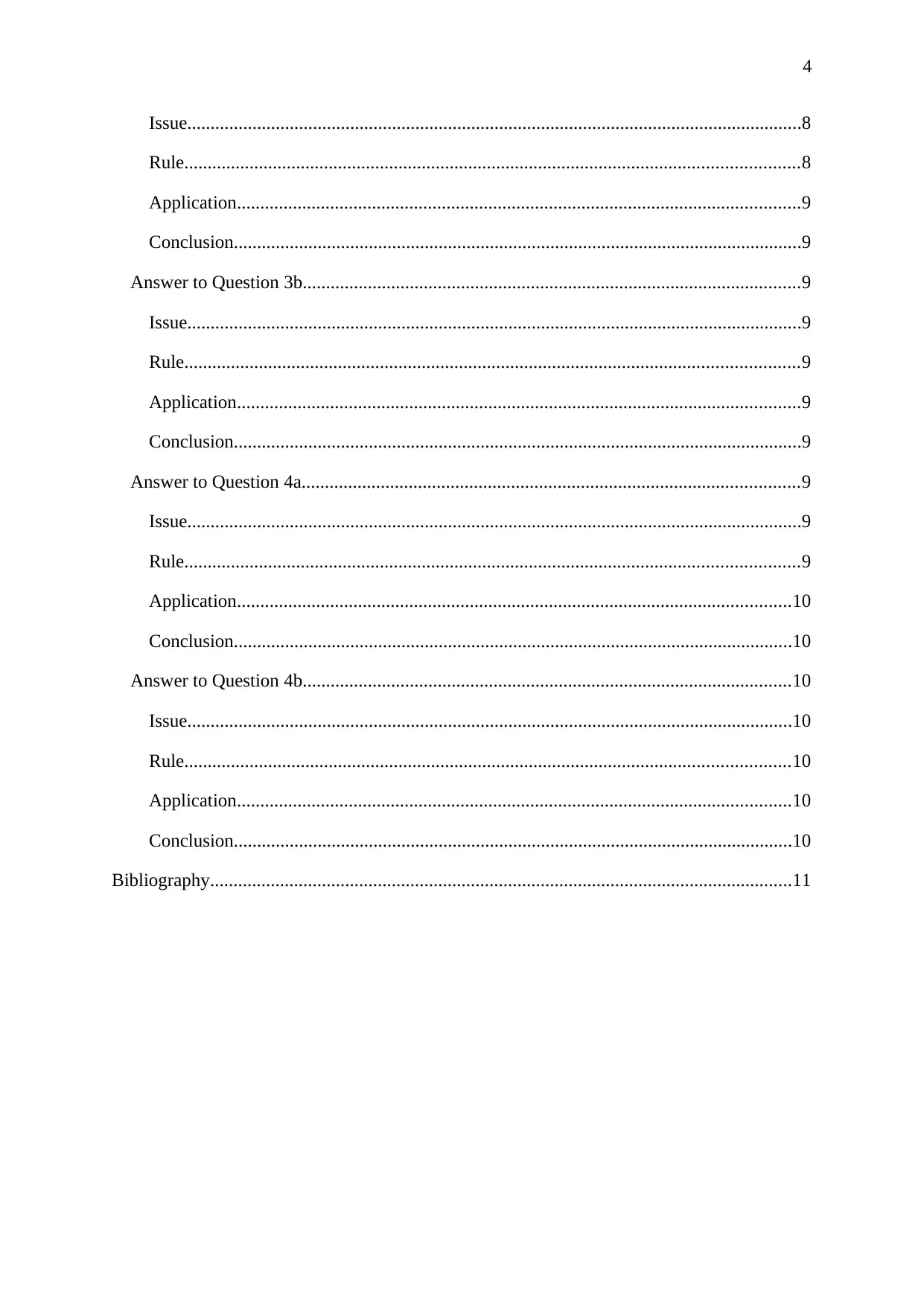
4
Issue....................................................................................................................................8
Rule....................................................................................................................................8
Application.........................................................................................................................9
Conclusion..........................................................................................................................9
Answer to Question 3b...........................................................................................................9
Issue....................................................................................................................................9
Rule....................................................................................................................................9
Application.........................................................................................................................9
Conclusion..........................................................................................................................9
Answer to Question 4a...........................................................................................................9
Issue....................................................................................................................................9
Rule....................................................................................................................................9
Application.......................................................................................................................10
Conclusion........................................................................................................................10
Answer to Question 4b.........................................................................................................10
Issue..................................................................................................................................10
Rule..................................................................................................................................10
Application.......................................................................................................................10
Conclusion........................................................................................................................10
Bibliography.............................................................................................................................11
Issue....................................................................................................................................8
Rule....................................................................................................................................8
Application.........................................................................................................................9
Conclusion..........................................................................................................................9
Answer to Question 3b...........................................................................................................9
Issue....................................................................................................................................9
Rule....................................................................................................................................9
Application.........................................................................................................................9
Conclusion..........................................................................................................................9
Answer to Question 4a...........................................................................................................9
Issue....................................................................................................................................9
Rule....................................................................................................................................9
Application.......................................................................................................................10
Conclusion........................................................................................................................10
Answer to Question 4b.........................................................................................................10
Issue..................................................................................................................................10
Rule..................................................................................................................................10
Application.......................................................................................................................10
Conclusion........................................................................................................................10
Bibliography.............................................................................................................................11
Paraphrase This Document
Need a fresh take? Get an instant paraphrase of this document with our AI Paraphraser
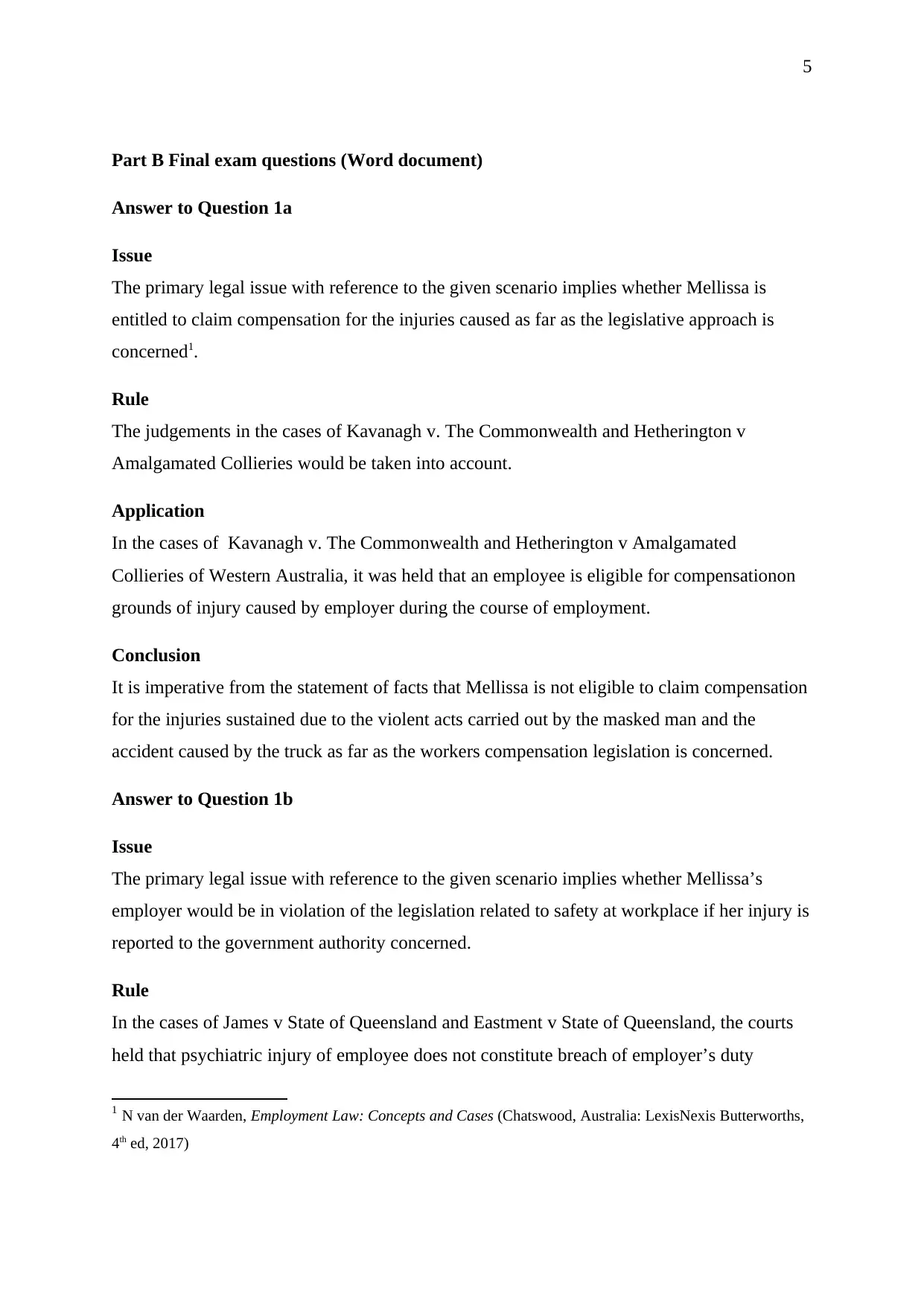
5
Part B Final exam questions (Word document)
Answer to Question 1a
Issue
The primary legal issue with reference to the given scenario implies whether Mellissa is
entitled to claim compensation for the injuries caused as far as the legislative approach is
concerned1.
Rule
The judgements in the cases of Kavanagh v. The Commonwealth and Hetherington v
Amalgamated Collieries would be taken into account.
Application
In the cases of Kavanagh v. The Commonwealth and Hetherington v Amalgamated
Collieries of Western Australia, it was held that an employee is eligible for compensationon
grounds of injury caused by employer during the course of employment.
Conclusion
It is imperative from the statement of facts that Mellissa is not eligible to claim compensation
for the injuries sustained due to the violent acts carried out by the masked man and the
accident caused by the truck as far as the workers compensation legislation is concerned.
Answer to Question 1b
Issue
The primary legal issue with reference to the given scenario implies whether Mellissa’s
employer would be in violation of the legislation related to safety at workplace if her injury is
reported to the government authority concerned.
Rule
In the cases of James v State of Queensland and Eastment v State of Queensland, the courts
held that psychiatric injury of employee does not constitute breach of employer’s duty
1 N van der Waarden, Employment Law: Concepts and Cases (Chatswood, Australia: LexisNexis Butterworths,
4th ed, 2017)
Part B Final exam questions (Word document)
Answer to Question 1a
Issue
The primary legal issue with reference to the given scenario implies whether Mellissa is
entitled to claim compensation for the injuries caused as far as the legislative approach is
concerned1.
Rule
The judgements in the cases of Kavanagh v. The Commonwealth and Hetherington v
Amalgamated Collieries would be taken into account.
Application
In the cases of Kavanagh v. The Commonwealth and Hetherington v Amalgamated
Collieries of Western Australia, it was held that an employee is eligible for compensationon
grounds of injury caused by employer during the course of employment.
Conclusion
It is imperative from the statement of facts that Mellissa is not eligible to claim compensation
for the injuries sustained due to the violent acts carried out by the masked man and the
accident caused by the truck as far as the workers compensation legislation is concerned.
Answer to Question 1b
Issue
The primary legal issue with reference to the given scenario implies whether Mellissa’s
employer would be in violation of the legislation related to safety at workplace if her injury is
reported to the government authority concerned.
Rule
In the cases of James v State of Queensland and Eastment v State of Queensland, the courts
held that psychiatric injury of employee does not constitute breach of employer’s duty
1 N van der Waarden, Employment Law: Concepts and Cases (Chatswood, Australia: LexisNexis Butterworths,
4th ed, 2017)
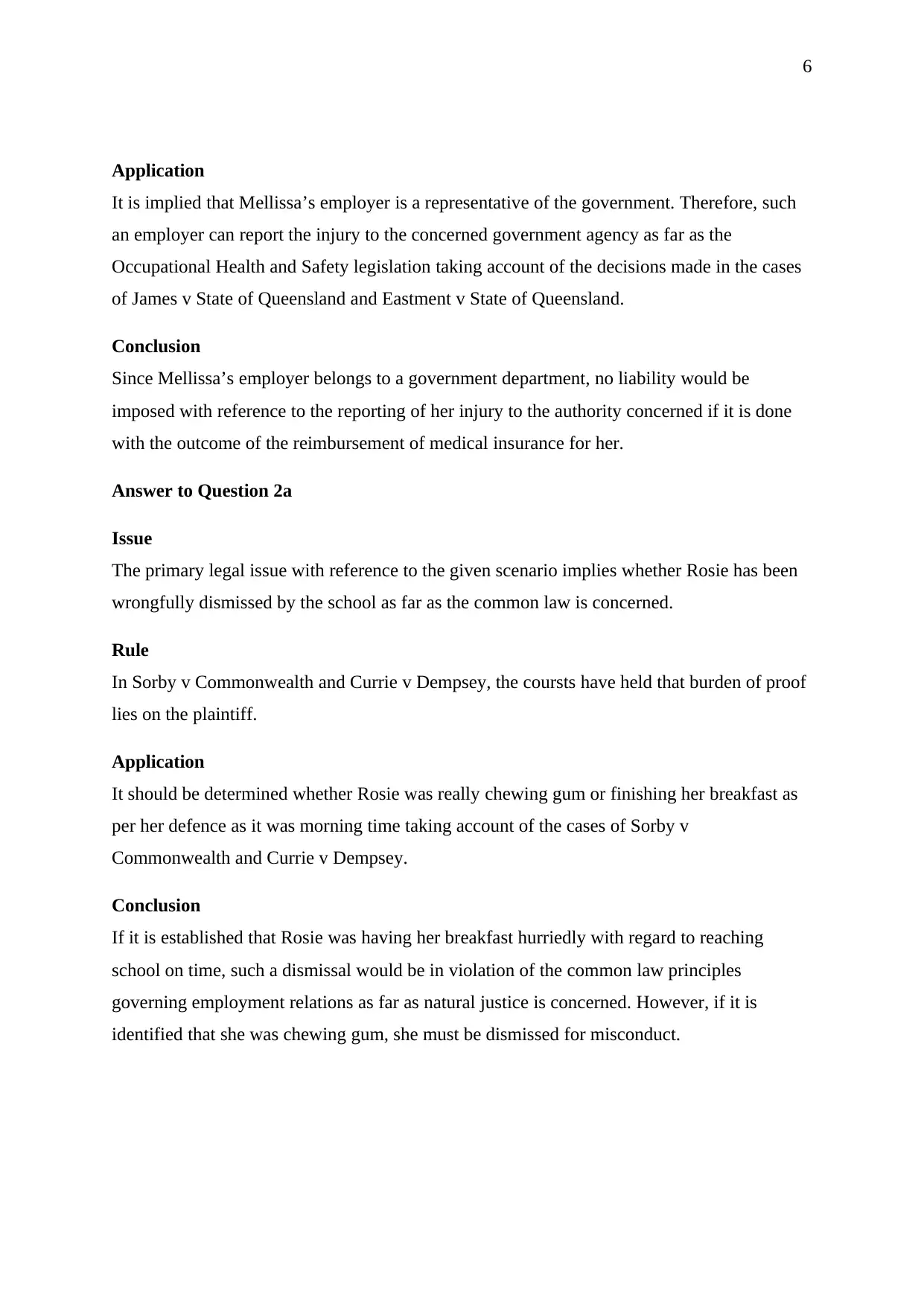
6
Application
It is implied that Mellissa’s employer is a representative of the government. Therefore, such
an employer can report the injury to the concerned government agency as far as the
Occupational Health and Safety legislation taking account of the decisions made in the cases
of James v State of Queensland and Eastment v State of Queensland.
Conclusion
Since Mellissa’s employer belongs to a government department, no liability would be
imposed with reference to the reporting of her injury to the authority concerned if it is done
with the outcome of the reimbursement of medical insurance for her.
Answer to Question 2a
Issue
The primary legal issue with reference to the given scenario implies whether Rosie has been
wrongfully dismissed by the school as far as the common law is concerned.
Rule
In Sorby v Commonwealth and Currie v Dempsey, the coursts have held that burden of proof
lies on the plaintiff.
Application
It should be determined whether Rosie was really chewing gum or finishing her breakfast as
per her defence as it was morning time taking account of the cases of Sorby v
Commonwealth and Currie v Dempsey.
Conclusion
If it is established that Rosie was having her breakfast hurriedly with regard to reaching
school on time, such a dismissal would be in violation of the common law principles
governing employment relations as far as natural justice is concerned. However, if it is
identified that she was chewing gum, she must be dismissed for misconduct.
Application
It is implied that Mellissa’s employer is a representative of the government. Therefore, such
an employer can report the injury to the concerned government agency as far as the
Occupational Health and Safety legislation taking account of the decisions made in the cases
of James v State of Queensland and Eastment v State of Queensland.
Conclusion
Since Mellissa’s employer belongs to a government department, no liability would be
imposed with reference to the reporting of her injury to the authority concerned if it is done
with the outcome of the reimbursement of medical insurance for her.
Answer to Question 2a
Issue
The primary legal issue with reference to the given scenario implies whether Rosie has been
wrongfully dismissed by the school as far as the common law is concerned.
Rule
In Sorby v Commonwealth and Currie v Dempsey, the coursts have held that burden of proof
lies on the plaintiff.
Application
It should be determined whether Rosie was really chewing gum or finishing her breakfast as
per her defence as it was morning time taking account of the cases of Sorby v
Commonwealth and Currie v Dempsey.
Conclusion
If it is established that Rosie was having her breakfast hurriedly with regard to reaching
school on time, such a dismissal would be in violation of the common law principles
governing employment relations as far as natural justice is concerned. However, if it is
identified that she was chewing gum, she must be dismissed for misconduct.
⊘ This is a preview!⊘
Do you want full access?
Subscribe today to unlock all pages.

Trusted by 1+ million students worldwide
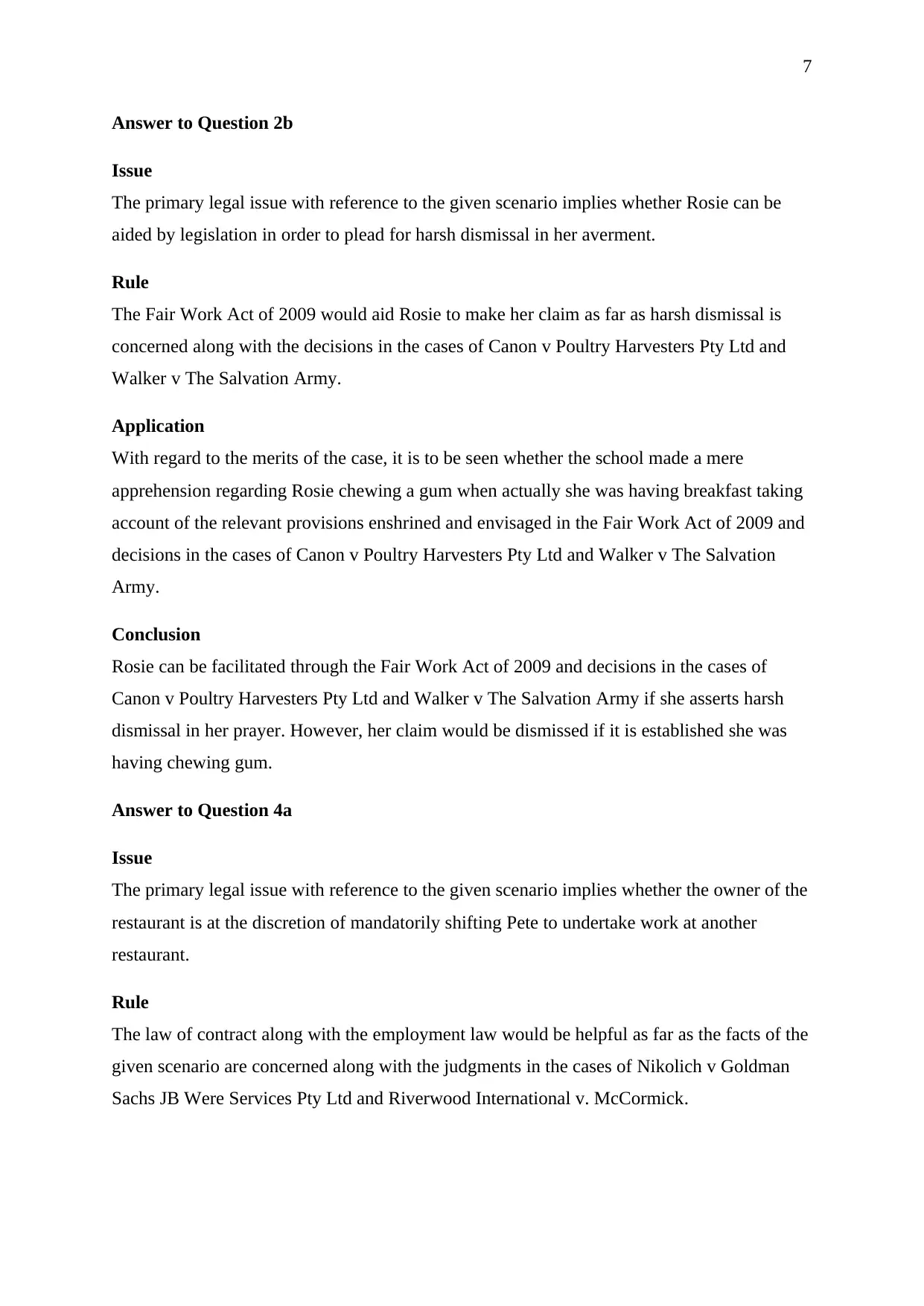
7
Answer to Question 2b
Issue
The primary legal issue with reference to the given scenario implies whether Rosie can be
aided by legislation in order to plead for harsh dismissal in her averment.
Rule
The Fair Work Act of 2009 would aid Rosie to make her claim as far as harsh dismissal is
concerned along with the decisions in the cases of Canon v Poultry Harvesters Pty Ltd and
Walker v The Salvation Army.
Application
With regard to the merits of the case, it is to be seen whether the school made a mere
apprehension regarding Rosie chewing a gum when actually she was having breakfast taking
account of the relevant provisions enshrined and envisaged in the Fair Work Act of 2009 and
decisions in the cases of Canon v Poultry Harvesters Pty Ltd and Walker v The Salvation
Army.
Conclusion
Rosie can be facilitated through the Fair Work Act of 2009 and decisions in the cases of
Canon v Poultry Harvesters Pty Ltd and Walker v The Salvation Army if she asserts harsh
dismissal in her prayer. However, her claim would be dismissed if it is established she was
having chewing gum.
Answer to Question 4a
Issue
The primary legal issue with reference to the given scenario implies whether the owner of the
restaurant is at the discretion of mandatorily shifting Pete to undertake work at another
restaurant.
Rule
The law of contract along with the employment law would be helpful as far as the facts of the
given scenario are concerned along with the judgments in the cases of Nikolich v Goldman
Sachs JB Were Services Pty Ltd and Riverwood International v. McCormick.
Answer to Question 2b
Issue
The primary legal issue with reference to the given scenario implies whether Rosie can be
aided by legislation in order to plead for harsh dismissal in her averment.
Rule
The Fair Work Act of 2009 would aid Rosie to make her claim as far as harsh dismissal is
concerned along with the decisions in the cases of Canon v Poultry Harvesters Pty Ltd and
Walker v The Salvation Army.
Application
With regard to the merits of the case, it is to be seen whether the school made a mere
apprehension regarding Rosie chewing a gum when actually she was having breakfast taking
account of the relevant provisions enshrined and envisaged in the Fair Work Act of 2009 and
decisions in the cases of Canon v Poultry Harvesters Pty Ltd and Walker v The Salvation
Army.
Conclusion
Rosie can be facilitated through the Fair Work Act of 2009 and decisions in the cases of
Canon v Poultry Harvesters Pty Ltd and Walker v The Salvation Army if she asserts harsh
dismissal in her prayer. However, her claim would be dismissed if it is established she was
having chewing gum.
Answer to Question 4a
Issue
The primary legal issue with reference to the given scenario implies whether the owner of the
restaurant is at the discretion of mandatorily shifting Pete to undertake work at another
restaurant.
Rule
The law of contract along with the employment law would be helpful as far as the facts of the
given scenario are concerned along with the judgments in the cases of Nikolich v Goldman
Sachs JB Were Services Pty Ltd and Riverwood International v. McCormick.
Paraphrase This Document
Need a fresh take? Get an instant paraphrase of this document with our AI Paraphraser
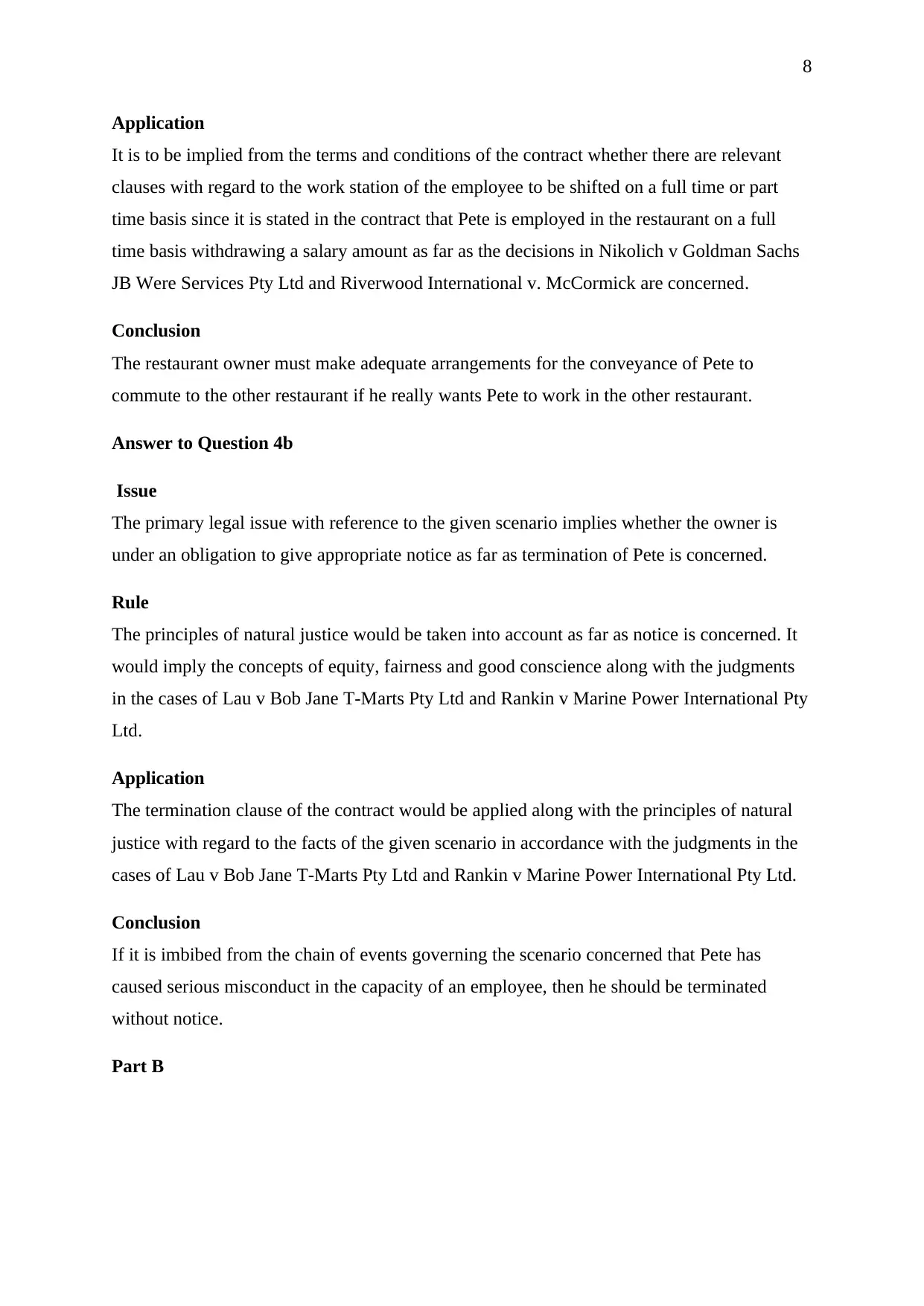
8
Application
It is to be implied from the terms and conditions of the contract whether there are relevant
clauses with regard to the work station of the employee to be shifted on a full time or part
time basis since it is stated in the contract that Pete is employed in the restaurant on a full
time basis withdrawing a salary amount as far as the decisions in Nikolich v Goldman Sachs
JB Were Services Pty Ltd and Riverwood International v. McCormick are concerned.
Conclusion
The restaurant owner must make adequate arrangements for the conveyance of Pete to
commute to the other restaurant if he really wants Pete to work in the other restaurant.
Answer to Question 4b
Issue
The primary legal issue with reference to the given scenario implies whether the owner is
under an obligation to give appropriate notice as far as termination of Pete is concerned.
Rule
The principles of natural justice would be taken into account as far as notice is concerned. It
would imply the concepts of equity, fairness and good conscience along with the judgments
in the cases of Lau v Bob Jane T-Marts Pty Ltd and Rankin v Marine Power International Pty
Ltd.
Application
The termination clause of the contract would be applied along with the principles of natural
justice with regard to the facts of the given scenario in accordance with the judgments in the
cases of Lau v Bob Jane T-Marts Pty Ltd and Rankin v Marine Power International Pty Ltd.
Conclusion
If it is imbibed from the chain of events governing the scenario concerned that Pete has
caused serious misconduct in the capacity of an employee, then he should be terminated
without notice.
Part B
Application
It is to be implied from the terms and conditions of the contract whether there are relevant
clauses with regard to the work station of the employee to be shifted on a full time or part
time basis since it is stated in the contract that Pete is employed in the restaurant on a full
time basis withdrawing a salary amount as far as the decisions in Nikolich v Goldman Sachs
JB Were Services Pty Ltd and Riverwood International v. McCormick are concerned.
Conclusion
The restaurant owner must make adequate arrangements for the conveyance of Pete to
commute to the other restaurant if he really wants Pete to work in the other restaurant.
Answer to Question 4b
Issue
The primary legal issue with reference to the given scenario implies whether the owner is
under an obligation to give appropriate notice as far as termination of Pete is concerned.
Rule
The principles of natural justice would be taken into account as far as notice is concerned. It
would imply the concepts of equity, fairness and good conscience along with the judgments
in the cases of Lau v Bob Jane T-Marts Pty Ltd and Rankin v Marine Power International Pty
Ltd.
Application
The termination clause of the contract would be applied along with the principles of natural
justice with regard to the facts of the given scenario in accordance with the judgments in the
cases of Lau v Bob Jane T-Marts Pty Ltd and Rankin v Marine Power International Pty Ltd.
Conclusion
If it is imbibed from the chain of events governing the scenario concerned that Pete has
caused serious misconduct in the capacity of an employee, then he should be terminated
without notice.
Part B
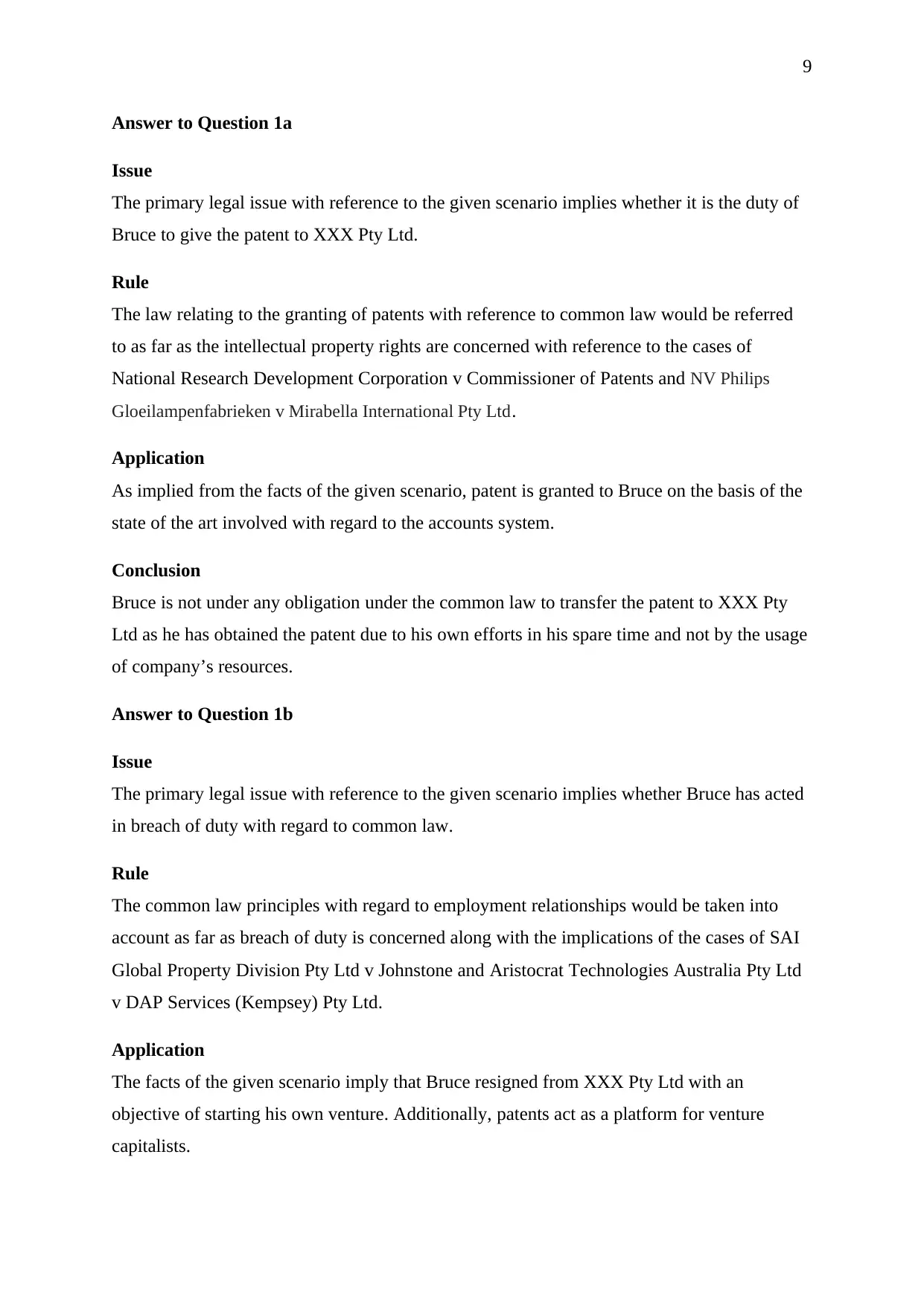
9
Answer to Question 1a
Issue
The primary legal issue with reference to the given scenario implies whether it is the duty of
Bruce to give the patent to XXX Pty Ltd.
Rule
The law relating to the granting of patents with reference to common law would be referred
to as far as the intellectual property rights are concerned with reference to the cases of
National Research Development Corporation v Commissioner of Patents and NV Philips
Gloeilampenfabrieken v Mirabella International Pty Ltd.
Application
As implied from the facts of the given scenario, patent is granted to Bruce on the basis of the
state of the art involved with regard to the accounts system.
Conclusion
Bruce is not under any obligation under the common law to transfer the patent to XXX Pty
Ltd as he has obtained the patent due to his own efforts in his spare time and not by the usage
of company’s resources.
Answer to Question 1b
Issue
The primary legal issue with reference to the given scenario implies whether Bruce has acted
in breach of duty with regard to common law.
Rule
The common law principles with regard to employment relationships would be taken into
account as far as breach of duty is concerned along with the implications of the cases of SAI
Global Property Division Pty Ltd v Johnstone and Aristocrat Technologies Australia Pty Ltd
v DAP Services (Kempsey) Pty Ltd.
Application
The facts of the given scenario imply that Bruce resigned from XXX Pty Ltd with an
objective of starting his own venture. Additionally, patents act as a platform for venture
capitalists.
Answer to Question 1a
Issue
The primary legal issue with reference to the given scenario implies whether it is the duty of
Bruce to give the patent to XXX Pty Ltd.
Rule
The law relating to the granting of patents with reference to common law would be referred
to as far as the intellectual property rights are concerned with reference to the cases of
National Research Development Corporation v Commissioner of Patents and NV Philips
Gloeilampenfabrieken v Mirabella International Pty Ltd.
Application
As implied from the facts of the given scenario, patent is granted to Bruce on the basis of the
state of the art involved with regard to the accounts system.
Conclusion
Bruce is not under any obligation under the common law to transfer the patent to XXX Pty
Ltd as he has obtained the patent due to his own efforts in his spare time and not by the usage
of company’s resources.
Answer to Question 1b
Issue
The primary legal issue with reference to the given scenario implies whether Bruce has acted
in breach of duty with regard to common law.
Rule
The common law principles with regard to employment relationships would be taken into
account as far as breach of duty is concerned along with the implications of the cases of SAI
Global Property Division Pty Ltd v Johnstone and Aristocrat Technologies Australia Pty Ltd
v DAP Services (Kempsey) Pty Ltd.
Application
The facts of the given scenario imply that Bruce resigned from XXX Pty Ltd with an
objective of starting his own venture. Additionally, patents act as a platform for venture
capitalists.
⊘ This is a preview!⊘
Do you want full access?
Subscribe today to unlock all pages.

Trusted by 1+ million students worldwide
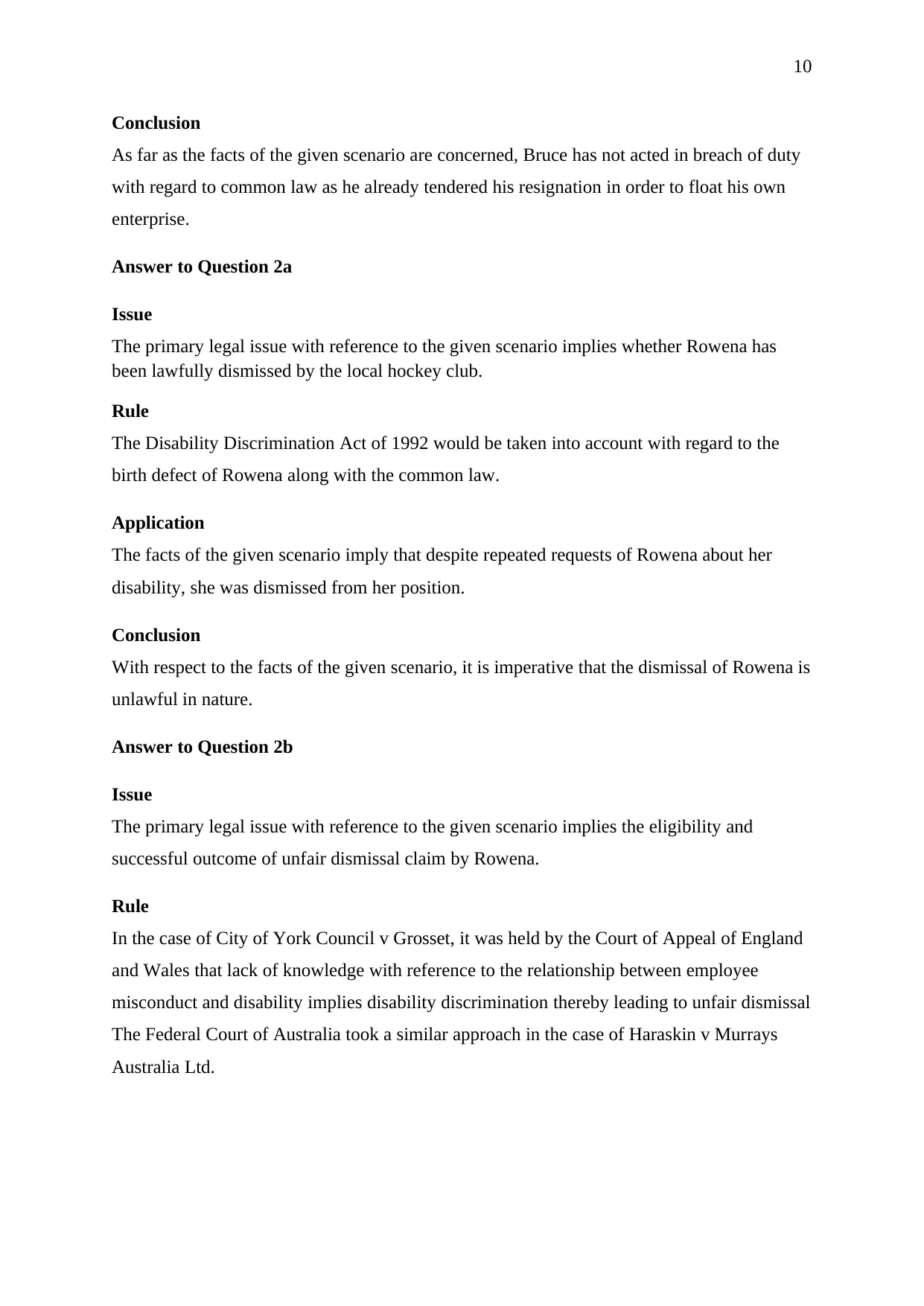
10
Conclusion
As far as the facts of the given scenario are concerned, Bruce has not acted in breach of duty
with regard to common law as he already tendered his resignation in order to float his own
enterprise.
Answer to Question 2a
Issue
The primary legal issue with reference to the given scenario implies whether Rowena has
been lawfully dismissed by the local hockey club.
Rule
The Disability Discrimination Act of 1992 would be taken into account with regard to the
birth defect of Rowena along with the common law.
Application
The facts of the given scenario imply that despite repeated requests of Rowena about her
disability, she was dismissed from her position.
Conclusion
With respect to the facts of the given scenario, it is imperative that the dismissal of Rowena is
unlawful in nature.
Answer to Question 2b
Issue
The primary legal issue with reference to the given scenario implies the eligibility and
successful outcome of unfair dismissal claim by Rowena.
Rule
In the case of City of York Council v Grosset, it was held by the Court of Appeal of England
and Wales that lack of knowledge with reference to the relationship between employee
misconduct and disability implies disability discrimination thereby leading to unfair dismissal
The Federal Court of Australia took a similar approach in the case of Haraskin v Murrays
Australia Ltd.
Conclusion
As far as the facts of the given scenario are concerned, Bruce has not acted in breach of duty
with regard to common law as he already tendered his resignation in order to float his own
enterprise.
Answer to Question 2a
Issue
The primary legal issue with reference to the given scenario implies whether Rowena has
been lawfully dismissed by the local hockey club.
Rule
The Disability Discrimination Act of 1992 would be taken into account with regard to the
birth defect of Rowena along with the common law.
Application
The facts of the given scenario imply that despite repeated requests of Rowena about her
disability, she was dismissed from her position.
Conclusion
With respect to the facts of the given scenario, it is imperative that the dismissal of Rowena is
unlawful in nature.
Answer to Question 2b
Issue
The primary legal issue with reference to the given scenario implies the eligibility and
successful outcome of unfair dismissal claim by Rowena.
Rule
In the case of City of York Council v Grosset, it was held by the Court of Appeal of England
and Wales that lack of knowledge with reference to the relationship between employee
misconduct and disability implies disability discrimination thereby leading to unfair dismissal
The Federal Court of Australia took a similar approach in the case of Haraskin v Murrays
Australia Ltd.
Paraphrase This Document
Need a fresh take? Get an instant paraphrase of this document with our AI Paraphraser
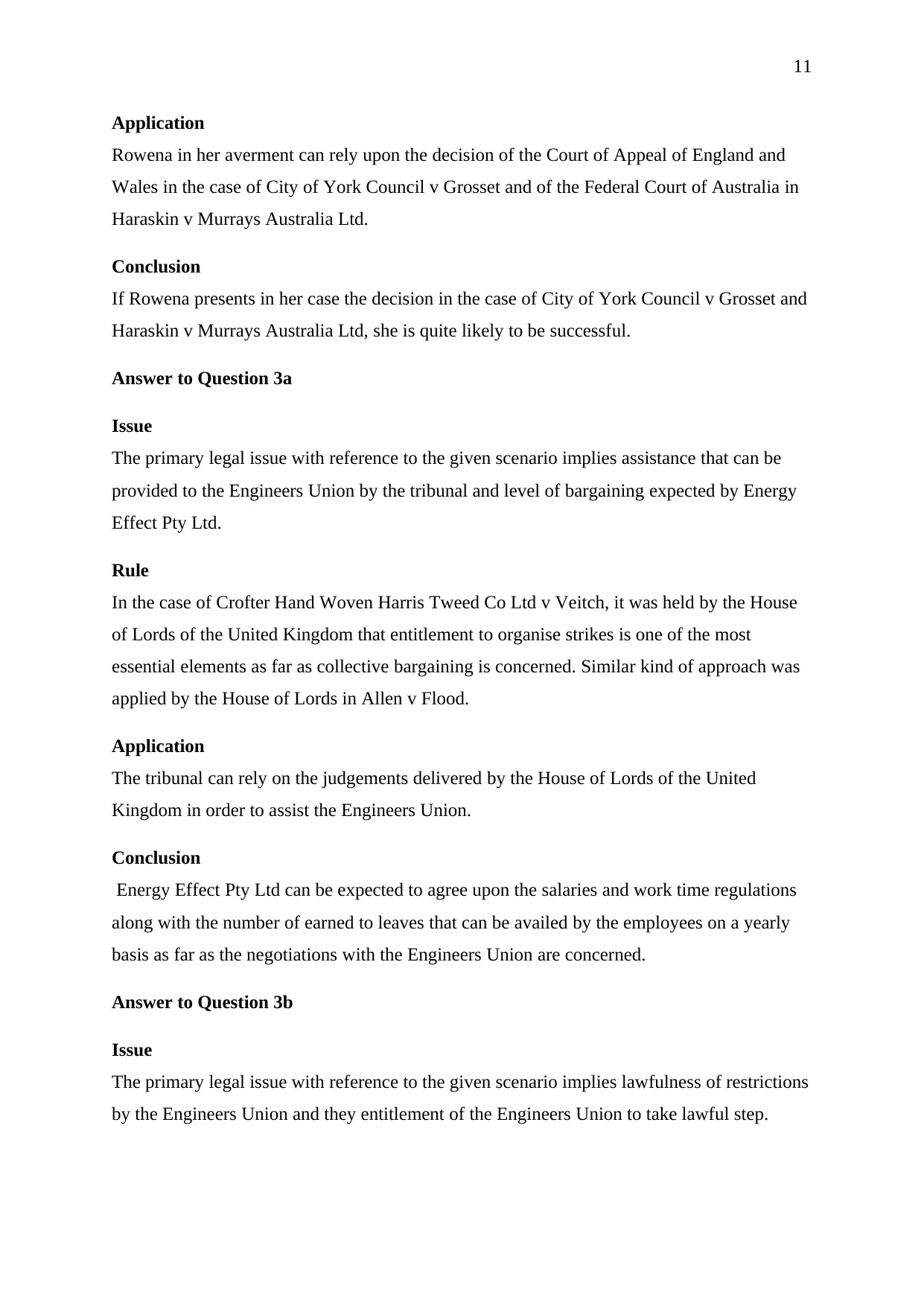
11
Application
Rowena in her averment can rely upon the decision of the Court of Appeal of England and
Wales in the case of City of York Council v Grosset and of the Federal Court of Australia in
Haraskin v Murrays Australia Ltd.
Conclusion
If Rowena presents in her case the decision in the case of City of York Council v Grosset and
Haraskin v Murrays Australia Ltd, she is quite likely to be successful.
Answer to Question 3a
Issue
The primary legal issue with reference to the given scenario implies assistance that can be
provided to the Engineers Union by the tribunal and level of bargaining expected by Energy
Effect Pty Ltd.
Rule
In the case of Crofter Hand Woven Harris Tweed Co Ltd v Veitch, it was held by the House
of Lords of the United Kingdom that entitlement to organise strikes is one of the most
essential elements as far as collective bargaining is concerned. Similar kind of approach was
applied by the House of Lords in Allen v Flood.
Application
The tribunal can rely on the judgements delivered by the House of Lords of the United
Kingdom in order to assist the Engineers Union.
Conclusion
Energy Effect Pty Ltd can be expected to agree upon the salaries and work time regulations
along with the number of earned to leaves that can be availed by the employees on a yearly
basis as far as the negotiations with the Engineers Union are concerned.
Answer to Question 3b
Issue
The primary legal issue with reference to the given scenario implies lawfulness of restrictions
by the Engineers Union and they entitlement of the Engineers Union to take lawful step.
Application
Rowena in her averment can rely upon the decision of the Court of Appeal of England and
Wales in the case of City of York Council v Grosset and of the Federal Court of Australia in
Haraskin v Murrays Australia Ltd.
Conclusion
If Rowena presents in her case the decision in the case of City of York Council v Grosset and
Haraskin v Murrays Australia Ltd, she is quite likely to be successful.
Answer to Question 3a
Issue
The primary legal issue with reference to the given scenario implies assistance that can be
provided to the Engineers Union by the tribunal and level of bargaining expected by Energy
Effect Pty Ltd.
Rule
In the case of Crofter Hand Woven Harris Tweed Co Ltd v Veitch, it was held by the House
of Lords of the United Kingdom that entitlement to organise strikes is one of the most
essential elements as far as collective bargaining is concerned. Similar kind of approach was
applied by the House of Lords in Allen v Flood.
Application
The tribunal can rely on the judgements delivered by the House of Lords of the United
Kingdom in order to assist the Engineers Union.
Conclusion
Energy Effect Pty Ltd can be expected to agree upon the salaries and work time regulations
along with the number of earned to leaves that can be availed by the employees on a yearly
basis as far as the negotiations with the Engineers Union are concerned.
Answer to Question 3b
Issue
The primary legal issue with reference to the given scenario implies lawfulness of restrictions
by the Engineers Union and they entitlement of the Engineers Union to take lawful step.
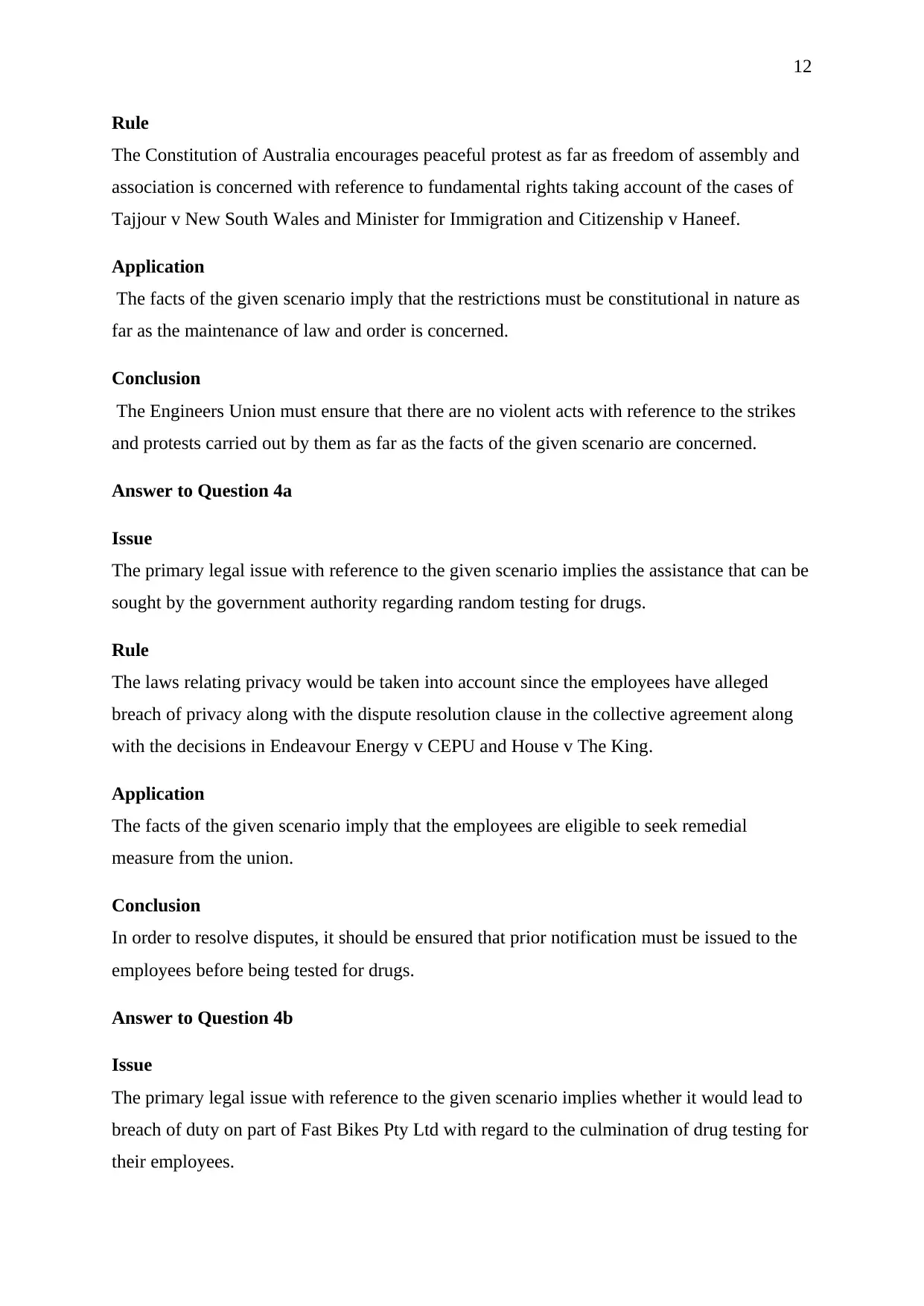
12
Rule
The Constitution of Australia encourages peaceful protest as far as freedom of assembly and
association is concerned with reference to fundamental rights taking account of the cases of
Tajjour v New South Wales and Minister for Immigration and Citizenship v Haneef.
Application
The facts of the given scenario imply that the restrictions must be constitutional in nature as
far as the maintenance of law and order is concerned.
Conclusion
The Engineers Union must ensure that there are no violent acts with reference to the strikes
and protests carried out by them as far as the facts of the given scenario are concerned.
Answer to Question 4a
Issue
The primary legal issue with reference to the given scenario implies the assistance that can be
sought by the government authority regarding random testing for drugs.
Rule
The laws relating privacy would be taken into account since the employees have alleged
breach of privacy along with the dispute resolution clause in the collective agreement along
with the decisions in Endeavour Energy v CEPU and House v The King.
Application
The facts of the given scenario imply that the employees are eligible to seek remedial
measure from the union.
Conclusion
In order to resolve disputes, it should be ensured that prior notification must be issued to the
employees before being tested for drugs.
Answer to Question 4b
Issue
The primary legal issue with reference to the given scenario implies whether it would lead to
breach of duty on part of Fast Bikes Pty Ltd with regard to the culmination of drug testing for
their employees.
Rule
The Constitution of Australia encourages peaceful protest as far as freedom of assembly and
association is concerned with reference to fundamental rights taking account of the cases of
Tajjour v New South Wales and Minister for Immigration and Citizenship v Haneef.
Application
The facts of the given scenario imply that the restrictions must be constitutional in nature as
far as the maintenance of law and order is concerned.
Conclusion
The Engineers Union must ensure that there are no violent acts with reference to the strikes
and protests carried out by them as far as the facts of the given scenario are concerned.
Answer to Question 4a
Issue
The primary legal issue with reference to the given scenario implies the assistance that can be
sought by the government authority regarding random testing for drugs.
Rule
The laws relating privacy would be taken into account since the employees have alleged
breach of privacy along with the dispute resolution clause in the collective agreement along
with the decisions in Endeavour Energy v CEPU and House v The King.
Application
The facts of the given scenario imply that the employees are eligible to seek remedial
measure from the union.
Conclusion
In order to resolve disputes, it should be ensured that prior notification must be issued to the
employees before being tested for drugs.
Answer to Question 4b
Issue
The primary legal issue with reference to the given scenario implies whether it would lead to
breach of duty on part of Fast Bikes Pty Ltd with regard to the culmination of drug testing for
their employees.
⊘ This is a preview!⊘
Do you want full access?
Subscribe today to unlock all pages.

Trusted by 1+ million students worldwide
1 out of 14
Related Documents
Your All-in-One AI-Powered Toolkit for Academic Success.
+13062052269
info@desklib.com
Available 24*7 on WhatsApp / Email
![[object Object]](/_next/static/media/star-bottom.7253800d.svg)
Unlock your academic potential
Copyright © 2020–2025 A2Z Services. All Rights Reserved. Developed and managed by ZUCOL.



![Organizational Development Report - [University Name] - Assessment 2](/_next/image/?url=https%3A%2F%2Fdesklib.com%2Fmedia%2Fimages%2Fgo%2F5f9da2471bf84aae9a939a44910220e0.jpg&w=256&q=75)

